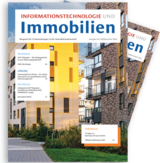Happy birthday easysquare!

IT&I: Mr. Kramer, the easysquare mobile brand has now existed for two years – congratulations. Would you describe to us when and how the idea for the actual product arose?
Jens Kramer: Before the times of tablets and smartphones, if anything at all, laptops were predominantly used as portable devices for mobile real estate management. However, they were unwieldy and unsuitable for spontaneous purposes, partly because programs or documents could only be opened with a delay. It soon became clear that a simpler solution was needed. In 2010, in collaboration with Jörn-Michael Westphal, the managing director of ProPotsdam, an initial idea was transformed into a concrete plan to program an app as a forms service on the practical, modern iPad. We purchased an iPad, then worked together with the IT department at PROMOS to develop and fine-tune the implementation. The main difficulty to begin with involved connecting the app to the SAP® system so that data could be transmitted. This was necessary, for example, to allow users to create form letters. PROMOS was already experienced in implementing document management with Microsoft Word in SAP® and was thus able, from a technical viewpoint, to incorporate all information into the new app.
IT&I: What was the difference compared to existing products?
Kramer: The app is based on the principle of a library and is therefore comparable to the function of PROMOS.GT. The key difference, though, is that the app can be made available directly as a mobile application and has a high proportion of code outside of SAP®. It was therefore crucial to launch it as an independent product on the market.
IT&I: When did you first present the app to the general public?
Kramer: After just a few months and many intensive hours working on developing it, we presented the new app at the Expo Real 2010. As the technology back then was not yet sufficiently sophisticated to accommodate such an innovation, an image of the iPad was projected onto a wall using a Polylux projector. At that time I presented a forms service with which electronic forms could be sent more quickly and easily. With just a few clicks, the app could be used in a similar way to an email program, with an inbox and outbox.
IT&I: What was the purpose of using the “forms service”?
Kramer: Previously, employees in the housing industry had worked with numerous reports and forms on paper, for instance when handing over residential properties or recording defects. The basic idea entailed processing and forwarding documents digitally using a mobile terminal device. Over the following months, various field types, as well as functions for placing signatures, implementing photos, highlighting things on photos, organising groups and producing subsheets, amongst other things, were added to the model. The concept was – and still is to this day – so flexible that it can be adapted to the individual forms used by different housing companies. During the development phase, we collected a huge pile of forms from various companies with which we had worked up to then and evaluated all the documents. In this way, we were able to find a way to incorporate the “form language” effectively into the app so that it could be adapted to meet individual company requirements. It is this basic principle that we find so clever about the idea, as we need just a single app for all transactions.
IT&I: Were there any obstacles to deal with?
Kramer: As is the case for every innovation, our app also had several hurdles to overcome. For many PROMOS customers, using an app on a modern device for respectable services was unthinkable. Most of them were inclined to consider the phenomenon of “apps” to be just a short-lived fashion. After all, the SAP® system had proven effective over many years and the housing associations feared that tenants would perceive them as pretentiously modern. In a very short time, however, it became apparent that the use of apps was coming to be considered increasingly useful and people could no longer imagine everyday life without them. Companies back then were, of course, a little anxious with regard to data security, which they perceived to be threatened by possible hacker attacks. We take fear of data misuse very seriously and follow all topical issues relating to it. Up to now, all attempts to decipher the Apple encryption algorithm have been unsuccessful. On top of this, we offer additional security solutions that are compatible with the easysquare mobile app where required.
IT&I: The new easysquare brand was launched two years ago. What do you associate with the name?
Kramer: The two components of the product’s name – “easy” and “square” (in the sense of marketplace) – speak for themselves really. It is the place where information comes together. The name “easysquare” therefore means that there is only one solution in the form of a marketplace where landlords can operate several different solutions in a customer-oriented manner and interconnect services. The name describes the multidimensional nature of this solution. “Easy” has always been our motto and still is today!
IT&I: How is the simplicity of the solution manifested?
Kramer: The easysquare mobile app does not
require any Internet access to operate the forms, can be used directly on
terminal devices thanks to its mobility and runs more smoothly than programs on
a PC. Our product allows us to provide customers with “360-degree all-round
support”, as we offer an appropriate solution for everyone involved in real
estate management. For example, landlords can also arrange an appointment with
the tradesmen directly using the app or house caretakers can access all service
specifications on site during a vacant apartment refurbishment, as they have
the entire service catalogue at hand. What is even more impressive is that,
alongside the progressing digitisation that is doing away with the huge piles
of paper seen in the past, responsibilities are also changing. The customers of
our customers – in other words the tenants – can suddenly spring into action
and initiate numerous processes themselves, with no need for anyone to sit at
the counter ready to help them as before. Nowadays, people can perform
practically any task with a few taps of the finger on their portable device, at
any location imaginable. Using the easysquare mobile app, house caretakers, who
previously had to take care of defects primarily at the property, can now also
send pictures and other information on site to the housing company’s SAP® system
or straight to the tradesmen and simply have to monitor the process using the
app. Since everyone involved in the housing industry now works with the app,
the design and symbols used were also very important in the development of the
app.
IT&I: Can you explain that in more detail?
Kramer: While developing the app, I performed my usability surveys directly with customers. I attended several training sessions for house caretakers with a view to establishing how user-friendly the app was, and this gave me lots of new ideas and inspiration. In the process, I became particularly aware that the design and symbols used play a key role in the product. The close collaboration between product managers and developers at PROMOS resulted in an even greater emphasis being placed on individual customer requirements.
IT&I: What changes have you observed over the past two years since the new brand was launched?
Kramer: Thanks to the easy operability and versatility of the app, we no longer serve just a sub-sector of the real estate industry. Even small entrepreneurs, such as private landlords renting out a small number of housing units, can monitor and organise their processes quickly and easily using our app. Thanks to the app, we are suddenly reaching target groups that we were unable to reach before. The easysquare mobile app has developed at a great pace over the course of two years. Our annual growth rate in the mobility business area amounts to over 40 percent. As a result, we currently have around 8,000 users on our platform. However, the progress is not only related to the app. During these two years there has been a general transition towards a digitised working environment. The period is characterised by a wide range of innovations and the associated changes in society. To this day, the easysquare mobile app is a pioneer in this area.
IT&I: Mr. Kramer, you have now described the last two years – how do you expect things to develop over the next two years?
Kramer: I anticipate that digitisation will
become even more widespread and also more diverse. Administrators will no
longer communicate with tenants by post, but rather directly using their
smartphones. For example, it will most certainly soon be possible to control
heating systems, electricity meters and sockets by app too. We also intend to integrate
individual tenants more and more into the easysquare mobile app. The aim here
is to enable them to query services themselves, for instance when looking for
suitable tradesmen or when looking for new tenants using a neighbourhood app.
There are no limits to the additional ideas for such extra functions. At
present, we can merely guess to what extent the trends will spread round the
globe and change our everyday lives.
redaktion@openpromos.de


